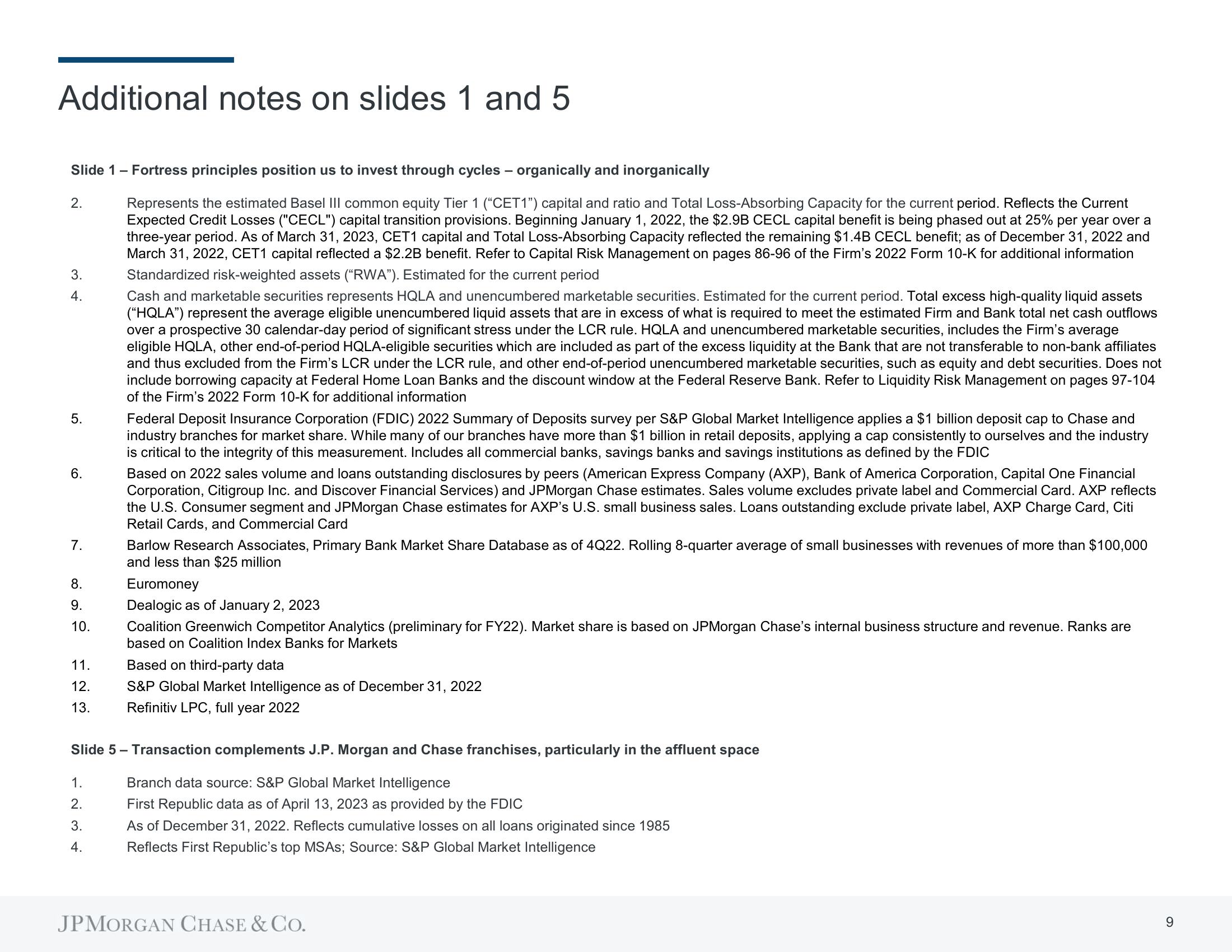J.P.Morgan Mergers and Acquisitions Presentation Deck
Additional notes on slides 1 and 5
Slide 1 - Fortress principles position us to invest through cycles - organically and inorganically
Represents the estimated Basel III common equity Tier 1 ("CET1") capital and ratio and Total Loss-Absorbing Capacity for the current period. Reflects the Current
Expected Credit Losses ("CECL") capital transition provisions. Beginning January 1, 2022, the $2.9B CECL capital benefit is being phased out at 25% per year over a
three-year period. As of March 31, 2023, CET1 capital and Total Loss-Absorbing Capacity reflected the remaining $1.4B CECL benefit; as of December 31, 2022 and
March 31, 2022, CET1 capital reflected a $2.2B benefit. Refer to Capital Risk Management on pages 86-96 of the Firm's 2022 Form 10-K for additional information
Standardized risk-weighted assets ("RWA"). Estimated for the current period
2.
3.
4.
5.
6.
7.
8.
9.
10.
11.
12.
13.
Cash and marketable securities represents HQLA and unencumbered marketable securities. Estimated for the current period. Total excess high-quality liquid assets
("HQLA") represent the average eligible unencumbered liquid assets that are in excess of what is required to meet the estimated Firm and Bank total net cash outflows
over a prospective 30 calendar-day period of significant stress under the LCR rule. HQLA and unencumbered marketable securities, includes the Firm's average
eligible HQLA, other end-of-period HQLA-eligible securities which are included as part of the excess liquidity at the Bank that are not transferable to non-bank affiliates
and thus excluded from the Firm's LCR under the LCR rule, and other end-of-period unencumbered marketable securities, such as equity and debt securities. Does not
include borrowing capacity at Federal Home Loan Banks and the discount window at the Federal Reserve Bank. Refer to Liquidity Risk Management on pages 97-104
of the Firm's 2022 Form 10-K for additional information
1.
2.
3.
4.
Federal Deposit Insurance Corporation (FDIC) 2022 Summary of Deposits survey per S&P Global Market Intelligence applies a $1 billion deposit cap to Chase and
industry branches for market share. While many of our branches have more than $1 billion in retail deposits, applying a cap consistently to ourselves and the industry
is critical to the integrity of this measurement. Includes all commercial banks, savings banks and savings institutions as defined by the FDIC
Based on 2022 sales volume and loans outstanding disclosures by peers (American Express Company (AXP), Bank of America Corporation, Capital One Financial
Corporation, Citigroup Inc. and Dis er nancial Services) and JPMorgan Chase estimates. Sales volume udes private label and Commercial Card. AXP reflects
the U.S. Consumer segment and JPMorgan Chase estimates for AXP's U.S. small business sales. Loans outstanding exclude private label, AXP Charge Card, Citi
Retail Cards, and Commercial Card
Barlow Research Associates, Primary Bank Market Share Database as of 4Q22. Rolling 8-quarter average of small businesses with revenues of more than $100,000
and less than $25 million
Euromoney
Dealogic as of January 2, 2023
Coalition Greenwich Competitor Analytics (preliminary for FY22). Market share is based on JPMorgan Chase's internal business structure and revenue. Ranks are
based on Coalition Index Banks for Markets
Based on third-party data
S&P Global Market Intelligence as of December 31, 2022
Refinitiv LPC, full year 2022
Slide 5 - Transaction complements J.P. Morgan and Chase franchises, particularly in the affluent space
Branch data source: S&P Global Market Intelligence
First Republic data as of April 13, 2023 as provided by the FDIC
As of December 31, 2022. Reflects cumulative losses on all loans originated since 1985
Reflects First Republic's top MSAS; Source: S&P Global Market Intelligence
JPMORGAN CHASE & Co.
9View entire presentation